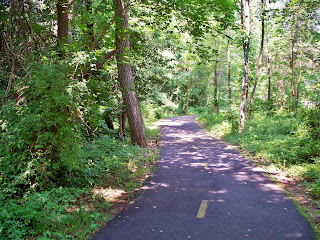Copyright © 2015
by Ralph F. Couey
It was a typical Virginia summer day. Which is to say very hot, oppressively humid, not usually a good day for hiking. But there was no severe weather in the forecast, which has not been the case in the two-and-a-half weeks since we returned from Paris. After perusing some options, we decided to go east instead of west, heading into, or at least close to D.C. to tackle the Mount Vernon Trail
The Trail is a paved multi-use path running from Alexandria down to George Washington's Mt. Vernon estate. Usually, a trail like this includes the risk of running afoul bicyclists who, in their minds, believe they're on part of the Tour de France. I've run into (or more accurately, been run into) by users of this ilk while running the W&OD trail through Vienna. With this in mind, I decided to put in at Fort Hunt Park, a good 14 miles south of DC proper. I'm not the only one who shares this opinion. Websites like Yelp are full of caustic and vitriolic comments about the few racers who frequent this trail, all of whom are universally described by a rather earthy word that begins with D.
It took the better part of 90 minutes to get there, as any DC commuter knows, point A to point B is rarely a straight line.
Fort Hunt Park is named for General Henry J. Hunt, the brilliant Civil War Union artillery commander. He fought for, and won the ability to deploy and use his guns as a separate unit, instead of having them assigned piecemeal to division commanders. He also was a ground-breaking tactician in the use of the guns, re-writing the artillery doctrine of not only the US army, but armies in Europe as well. The land was actually part of Washington's Mt. Vernon estate until the beginning of the 19th century, when the land passed out of the family's ownership. It was farmland until 1897 when the fort was constructed, one of a series of forts along the Potomac River intended to protect the easy and obvious sea route to the National Capital. Across the Potomac, you can clearly see the imposing edifice of Fort Washington, on the Maryland side of the river. The two installations created a dangerous gauntlet for any invading force to run. Fortunately, nobody ever tried to invade DC during that time. In the 1930's it was converted to a CCC camp, and during World War II, it became a top secret military intelligence base, known by the innocuous "P.O. Box 1142." It was here that high-value POW's were interrogated, and was the place where the highest-ranking German officer (Lt. Cdr Werner Henke, Commanding Officer of the submarine U-515) to be killed while in American custody met his end while attempting to escape in 1944. By November 1946, the last German prisoner was released and the property was turned over to the National Park Service.
Today, the park is home to a meandering trail that winds around picnic shelters and ball fields, while passing by the remaining gun emplacements.
The Mount Vernon Trail parallels the George Washington Memorial Parkway and our put-in point was located at the east end of the park where Ft. Hunt Road T's into the Parkway. We crossed the driveway, took a turn through a stone overpass and got onto the trail.
Ft. Washington
The trail itself, as I mentioned, is paved, and as I was soon to discover, is a surface really meant more for tennis shoes rather than hiking boots. After logging some 70 miles on the Appalachian Trail over the past two years, today I raised my first set of blisters with these boots. The sky was perfect, but the heat and humidity made itself felt before we had gone more than a mile. We were grateful for any shade we found.
We got within sight of the entrance to the Mount Vernon historical park, but decided to turn and head back. Of course, it got warmer and more humid as we walked. We stopped about halfway back for a rest and to apply some first aid to my blisters. On a better day, it would have been an ideal hike. Today, it was just too much. Cheryl had a headache, and I was pretty poohed out when we returned to Fort Hunt and the car.
It was a long one for us, 7.6 miles on a day when 3 miles would have been just fine.


















No comments:
Post a Comment